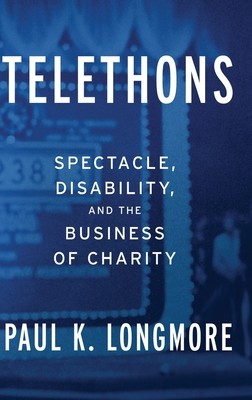
- We will send in 10–14 business days.
- Author: Paul K Longmore
- Publisher: Oxford University Press, USA
- ISBN-10: 0190262079
- ISBN-13: 9780190262075
- Format: 15.8 x 23.6 x 3.1 cm, hardcover
- Language: English
- SAVE -10% with code: EXTRA
Reviews
Description
Movie stars, entertainers, game-show hosts, jugglers, plate-spinners, gospel choirs, corporate executives posing with over-sized checks, household name-brand products, smiling children in leg braces-all were fixtures of the phenomenon that defined American culture in the second half of the twentieth century: the telethon. Hundreds of millions watched these weekend-long variety shows that raised billions of dollars for disability-related charities. Drawing on over two decades of in-depth research, Telethons trenchantly explores the complexity underneath the campy spectacles. At its center are the disabled children, who, thanks to a particular kind of historical-cultural marginalization, turned out to be ideal tools for promoting corporate interests, privatized healthcare, and class status. Offering a public message about helping these unfortunate victims, telethons perpetuated a misleading image of people with disabilities as helpless, passive, apolitical members of American
society. Paul K. Longmore's revelatory chronicle shows how these images in fact helped major corporations increase their bottom lines, while filling gaps in the strange public-private hybrid U.S. health insurance system. Only once disabled people pushed back in public protests did the broader implications for all Americans become clear.
and triumph that were not center-stage on these popular telecasts by offering insights into the U.S. disability movement past and present.
EXTRA 10 % discount with code: EXTRA
The promotion ends in 17d.17:23:37
The discount code is valid when purchasing from 10 €. Discounts do not stack.
- Author: Paul K Longmore
- Publisher: Oxford University Press, USA
- ISBN-10: 0190262079
- ISBN-13: 9780190262075
- Format: 15.8 x 23.6 x 3.1 cm, hardcover
- Language: English English
Movie stars, entertainers, game-show hosts, jugglers, plate-spinners, gospel choirs, corporate executives posing with over-sized checks, household name-brand products, smiling children in leg braces-all were fixtures of the phenomenon that defined American culture in the second half of the twentieth century: the telethon. Hundreds of millions watched these weekend-long variety shows that raised billions of dollars for disability-related charities. Drawing on over two decades of in-depth research, Telethons trenchantly explores the complexity underneath the campy spectacles. At its center are the disabled children, who, thanks to a particular kind of historical-cultural marginalization, turned out to be ideal tools for promoting corporate interests, privatized healthcare, and class status. Offering a public message about helping these unfortunate victims, telethons perpetuated a misleading image of people with disabilities as helpless, passive, apolitical members of American
society. Paul K. Longmore's revelatory chronicle shows how these images in fact helped major corporations increase their bottom lines, while filling gaps in the strange public-private hybrid U.S. health insurance system. Only once disabled people pushed back in public protests did the broader implications for all Americans become clear.
and triumph that were not center-stage on these popular telecasts by offering insights into the U.S. disability movement past and present.


Reviews